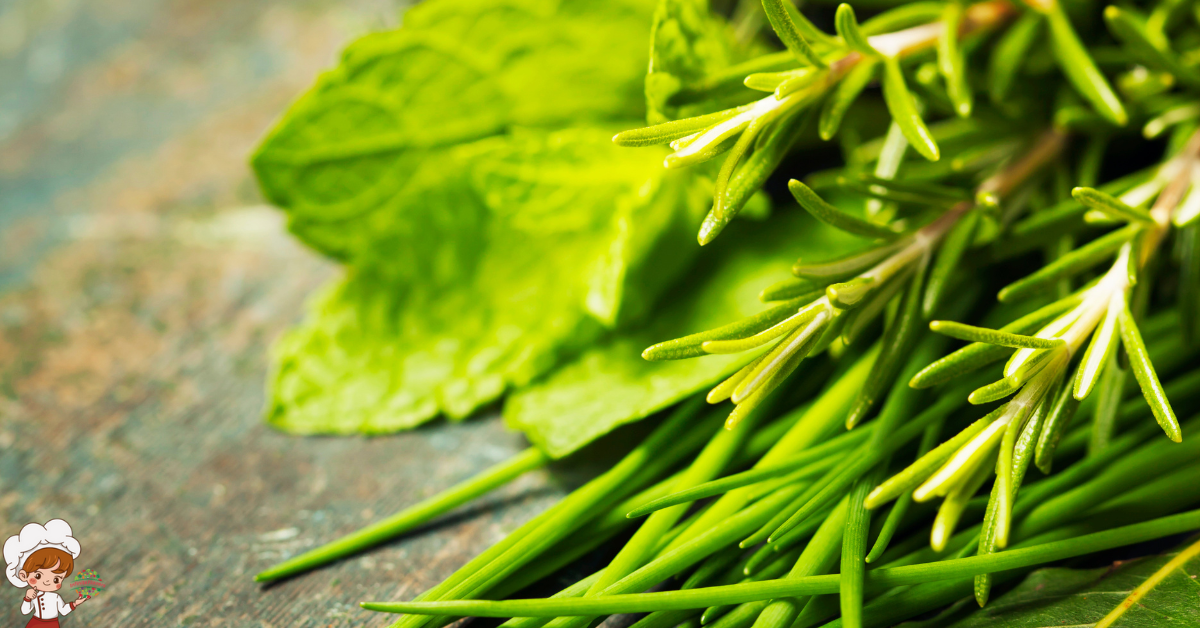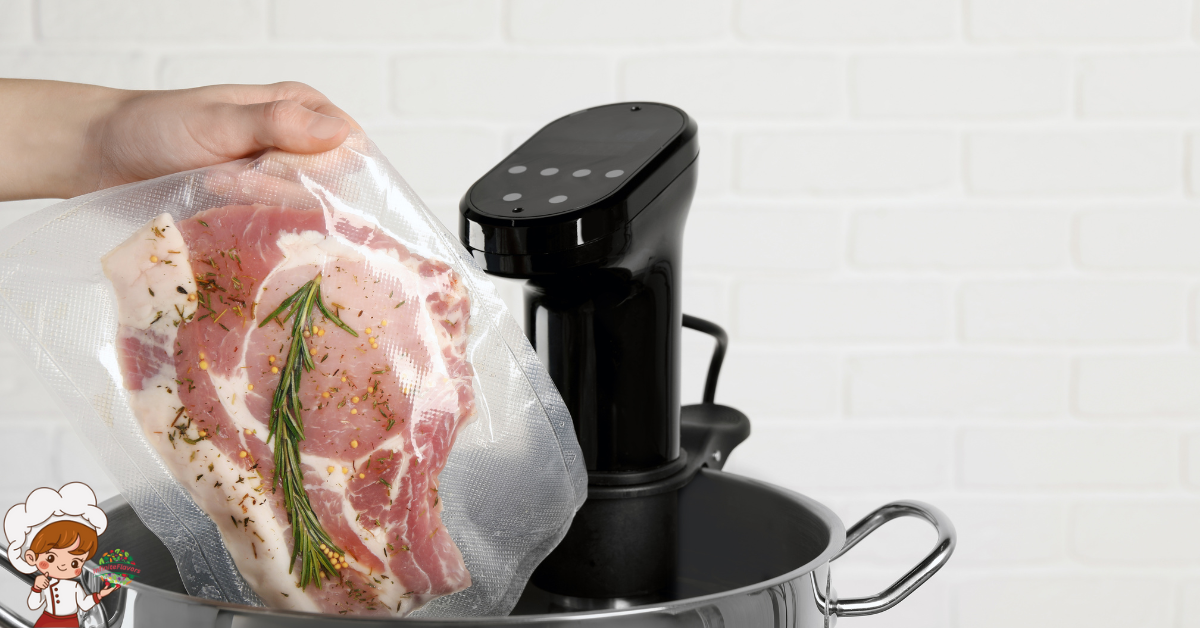History And How To Make Caesar Dressing
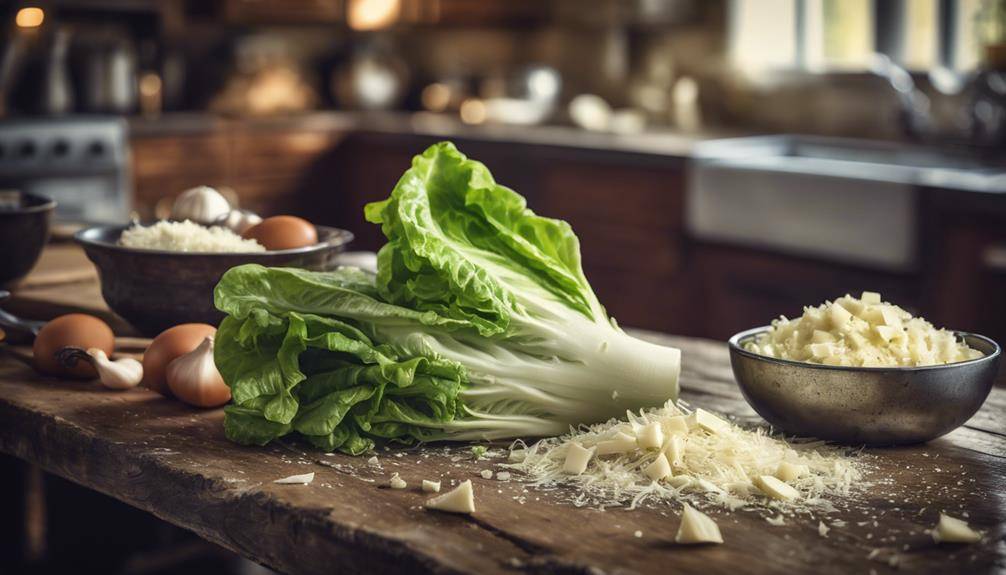
How To Make Caesar Dressing, a beloved classic, was born out of necessity in the 1920s by Italian immigrant Caesar Cardini in Mexico. To whip it up, whisk together garlic, anchovies, and egg yolks, then slowly drizzle in high-quality olive oil for creaminess. Fresh lemon juice and grated Parmesan add brightness and umami. Season to taste with salt and pepper, and you’ve got a delicious dressing. Feel free to explore variations like vegan options or serving suggestions to make it your own. If you’re curious about how to elevate your Caesar experience, you might just find some inspiration ahead.
Origins of Caesar Dressing
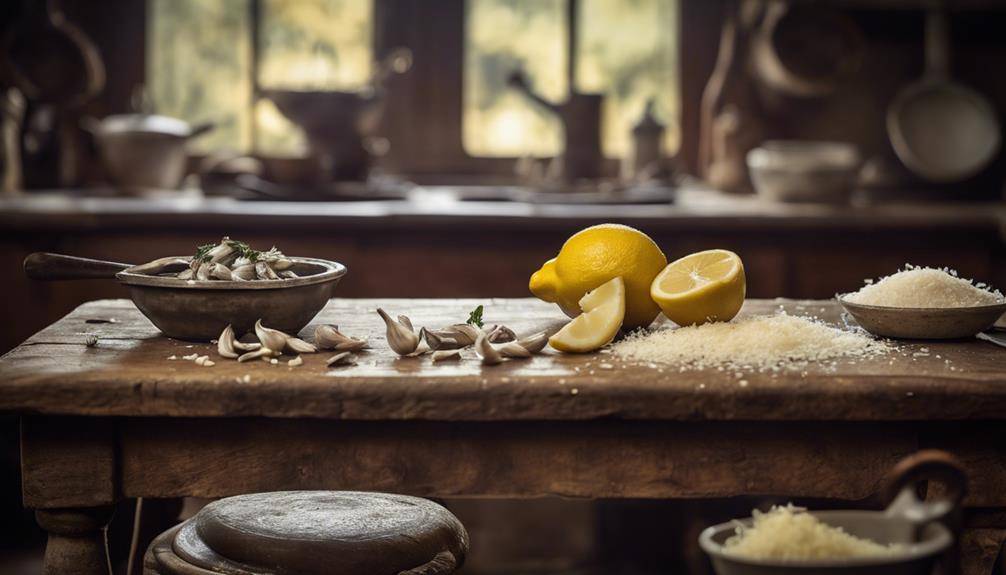
Caesar dressing, with its roots in early 20th-century Mexico, was created by Italian immigrant Caesar Cardini in his restaurant. Located in Tijuana, Cardini’s establishment catered to Americans during Prohibition, offering a unique dining experience. You might find it fascinating that the original Caesar salad, which paired perfectly with his dressing, was invented on a busy Fourth of July weekend when supplies were low. Cardini had to improvise, combining simple ingredients that would later define this iconic dish.
As you explore culinary history, you’ll discover how Cardini’s creation quickly gained popularity, spreading beyond Tijuana and becoming a staple in American cuisine. The balance of flavors in Caesar dressing—anchovies, garlic, lemon juice, and Parmesan—evolved into a beloved addition to not just salads but various dishes. Over the years, many chefs have put their spin on the classic recipe, but Cardini’s original version remains a benchmark in the culinary world.
When you think of Caesar salad today, it’s hard not to envision the creamy dressing that brings it to life. Whether you enjoy it in a restaurant or whip it up at home, you’re partaking in a rich history that has transcended borders and generations. By understanding its origins, you can appreciate the dressing’s lasting influence on modern cuisine and perhaps even endeavor to recreate that authentic taste in your own kitchen.
Key Ingredients Explained

When you’re making Caesar dressing, understanding the key ingredients is essential. Olive oil adds richness, while anchovies contribute a distinctive umami flavor. Plus, garlic brings everything together with its bold aroma and taste.
Olive Oil Importance
Olive oil plays an essential role in creating a rich, creamy texture that elevates your Caesar dressing to new heights. When you choose high-quality olive oil, you’re not just enhancing flavor; you’re also tapping into its numerous health benefits. This oil is packed with antioxidants and healthy fats that can boost heart health and improve cholesterol levels.
Using good oil quality is vital for achieving that perfect balance in your dressing. Low-quality oils may have a harsh taste and can even diminish the overall experience of your Caesar salad. You want an oil that’s smooth and fruity, which complements the other ingredients beautifully.
When you whisk together olive oil with lemon juice, garlic, and Parmesan, the result is a velvety dressing that clings perfectly to your greens. Plus, the health benefits of olive oil make it a guilt-free indulgence. It’s a simple yet powerful ingredient that makes your Caesar dressing not only delicious but nutritious too. So, don’t skimp on the olive oil—invest in a good bottle, and your Caesar dressing will shine!
Anchovy Flavor Profile
Anchovies add a unique depth of flavor to your dressing, bringing a savory umami element that enhances the overall taste profile of the Caesar salad. Their distinctive anchovy saltiness contributes a rich, briny taste that balances well with other ingredients, making your dressing truly stand out. When you use anchovies, you’re not just adding fish; you’re elevating every bite with layers of flavor.
If you’re concerned about the strong taste of anchovies or if you prefer a vegetarian option, there are anchovy substitutes you can try. Ingredients like miso paste can mimic the umami flavor, while capers provide a similar briny kick. You might also consider using soy sauce for a salty depth, but keep in mind that it won’t replicate the fishiness completely.
When using anchovies, a little goes a long way. Just a couple of fillets mixed into your dressing can greatly transform your Caesar salad. So, embrace the anchovy flavor profile, and don’t shy away from experimenting with these substitutes if you want something a bit different. Your salad will still be delicious!
Garlic’s Essential Role
Garlic plays an essential role in Caesar dressing, bringing a bold, aromatic flavor that elevates the entire salad experience. Its pungent taste not only enhances the dressing but also complements the richness of the other ingredients, like anchovies and Parmesan cheese. When you add fresh minced garlic, you’re introducing a layer of flavor that makes your Caesar salad unforgettable.
Beyond its flavor enhancement, garlic also offers numerous health benefits. It’s known for its anti-inflammatory and antioxidant properties, which can help boost your immune system. Incorporating garlic into your diet may also support cardiovascular health by regulating blood pressure and cholesterol levels.
When making Caesar dressing, consider using fresh garlic instead of pre-minced options. Fresh garlic has a more vibrant flavor and retains more of its health benefits. You can adjust the amount to your taste preference, but even a little goes a long way in transforming your dressing.
Traditional Preparation Method
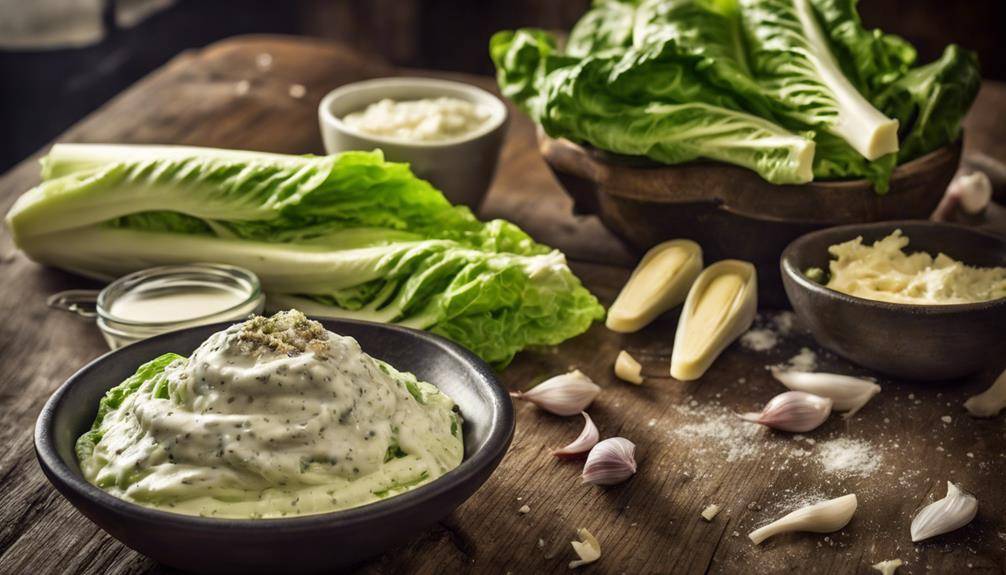
To make traditional Caesar dressing, you’ll need to whisk together fresh ingredients to create a creamy and flavorful base. Start with fresh garlic, anchovies, and egg yolks. These ingredients form the heart of the dressing, providing depth and richness. Use traditional techniques like emulsifying the egg yolks with olive oil to achieve that smooth, creamy texture. Slowly drizzle the olive oil into the mixture while whisking vigorously to incorporate it thoroughly.
Next, add freshly squeezed lemon juice, which brightens the flavor, and a generous amount of freshly grated Parmesan cheese for that signature umami kick. You can season with salt and freshly cracked black pepper to taste. Some traditional recipes also call for a dash of Worcestershire sauce, enhancing the umami profile even more.
As you prepare your dressing, keep in mind that regional variations exist. For instance, some Italian versions might include different herbs or even a splash of red wine vinegar, while others might emphasize the use of different types of cheese. However, the essence of traditional Caesar dressing remains constant: a balance of creamy, tangy, and savory flavors.
Once you’ve whisked everything together, taste and adjust the seasoning as needed. Your traditional Caesar dressing is now ready to elevate your salads or serve as a dip, embodying the timeless flavors that have made it a beloved classic. Enjoy the satisfaction of creating this delicious dressing from scratch!
Variations of Caesar Dressing
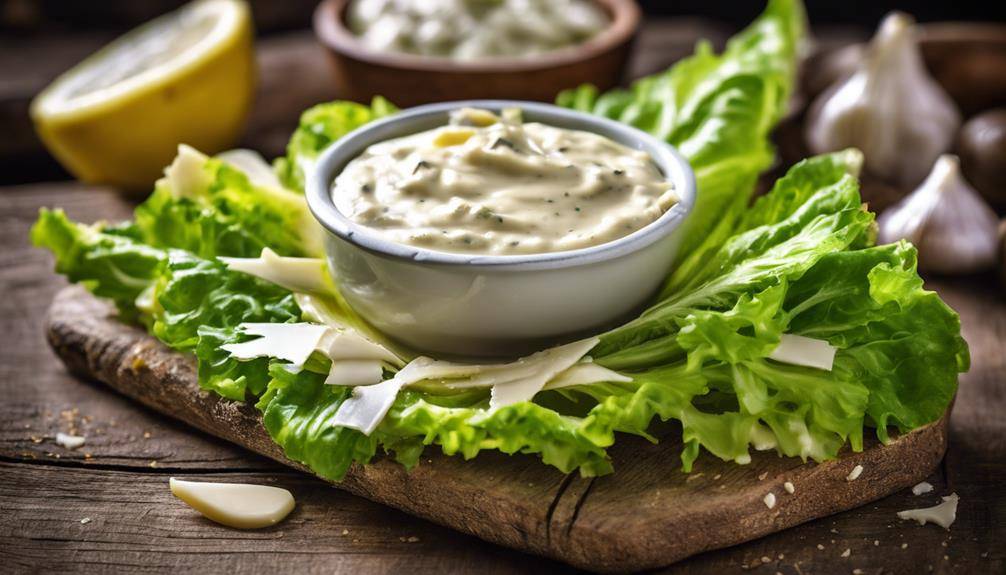
When it comes to Caesar dressing, there are plenty of ways to mix things up. You can stick with the classic recipe or explore vegan options that still pack a flavorful punch. Let’s look at how these variations can elevate your salads!
Classic Caesar Dressing Recipe
Creating a classic Caesar dressing requires just a few simple ingredients and a quick blend for a rich, tangy flavor that elevates any salad. Start with two cloves of garlic, minced, and combine them in a bowl with two anchovy fillets, which you’ll mash into a paste. Add the juice of one lemon, a teaspoon of Dijon mustard, and a pinch of salt.
Next, slowly whisk in about half a cup of extra virgin olive oil until the dressing emulsifies. For a creamier texture, stir in a quarter cup of freshly grated Parmesan cheese. This classic dressing works perfectly drizzled over a traditional Caesar salad, combining crisp romaine lettuce, croutons, and more Parmesan for a satisfying bite.
If you’re looking for dressing alternatives, consider adding a dash of Worcestershire sauce or a sprinkle of black pepper for added depth. You can also tweak the recipe to suit your taste by adjusting the garlic or anchovy levels. Whatever you choose, your Caesar salad will surely benefit from this delightful dressing, making every bite a flavorful experience.
Vegan Caesar Dressing Options
Vegan Caesar dressing offers a delicious alternative that captures the classic flavors without any animal products. You can create a creamy, satisfying dressing using vegan substitutes like cashews, tahini, or silken tofu. Simply blend these ingredients with garlic, lemon juice, nutritional yeast, and a touch of Dijon mustard for that signature tang.
Nutritional benefits abound in these vegan options. For instance, cashews provide healthy fats and protein, while nutritional yeast adds a cheesy flavor along with essential B vitamins. Using plant-based ingredients not only caters to dietary preferences but also enhances your meal’s nutritional profile.
If you want to get creative, try adding a dash of smoked paprika or capers for an extra kick. You can also experiment with different herbs, like basil or parsley, to give your dressing a fresh twist.
This vegan Caesar dressing pairs perfectly with crisp romaine lettuce, croutons, or even as a dipping sauce for veggies. Embrace these variations to enjoy a rich flavor experience that aligns with your values, making your meals both tasty and nourishing.
Tips for the Perfect Dressing

To achieve the perfect Caesar dressing, focus on balancing the flavors of garlic, anchovy, and Parmesan for a rich and creamy result. Start by mincing fresh garlic and letting it sit for about 10 minutes before mixing it in. This enhances its flavor, creating a more aromatic base. If you’re using anchovy fillets, mash them into a paste for better incorporation into the dressing; this also helps to accomplish that much-loved umami punch.
Next, whisk in the egg yolk—this is essential for attaining a smooth, creamy texture. For dressing consistency, consider adding Dijon mustard, which not only thickens the mix but also adds a subtle tang. When you’re blending your ingredients, drizzle in olive oil slowly to create an emulsion. This process guarantees that the oil combines well with the other ingredients, leading to a luxurious mouthfeel.
Don’t overlook the importance of freshly grated Parmesan; it’s key to accomplishing that authentic Caesar flavor balance. Start with a small amount and taste as you go, adjusting to your preference. You can also add a splash of lemon juice for brightness, but be careful not to overpower the other flavors.
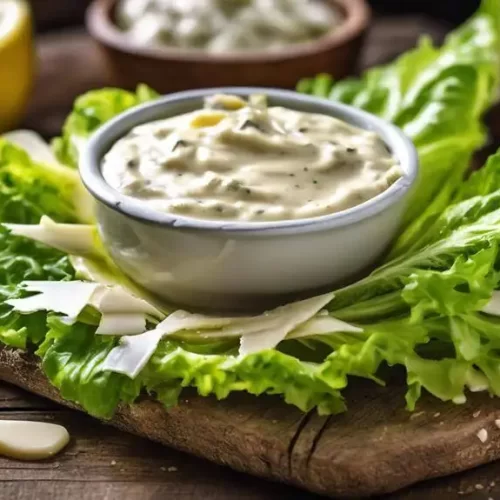
Classic Caesar Dressing Recipe
Ingredients
- Ingredients:
- 2-3 cloves garlic minced
- 1 teaspoon anchovy paste or 2-3 anchovy fillets, minced
- 1 teaspoon Dijon mustard
- 1 tablespoon Worcestershire sauce
- 2 tablespoons freshly squeezed lemon juice
- 1 teaspoon red wine vinegar optional
- 1 cup mayonnaise
- 1/2 cup freshly grated Parmesan cheese
- Salt and freshly ground black pepper to taste
- 1/4 cup extra-virgin olive oil
Instructions
- Instructions:
- Prepare the Base:
- In a medium bowl, combine the minced garlic, anchovy paste (or minced anchovies), Dijon mustard, Worcestershire sauce, lemon juice, and red wine vinegar (if using). Whisk together until smooth.
- Add Mayonnaise and Parmesan:
- Add the mayonnaise and freshly grated Parmesan cheese to the bowl. Whisk until well combined.
- Season:
- Season the mixture with salt and freshly ground black pepper to taste. Be cautious with the salt, as the anchovies and Parmesan cheese are already salty.
- Incorporate Olive Oil:
- While whisking constantly, slowly drizzle in the extra-virgin olive oil until the dressing is well emulsified and smooth.
- Adjust Consistency:
- If the dressing is too thick, you can thin it out with a little bit of water or more lemon juice until you reach your desired consistency.
- Taste and Adjust:
- Taste the dressing and adjust the seasoning if needed, adding more lemon juice, salt, or pepper as desired.
- Serve:
- Use the Caesar dressing immediately or refrigerate it in an airtight container for up to 1 week.
Serving Suggestions and Pairings
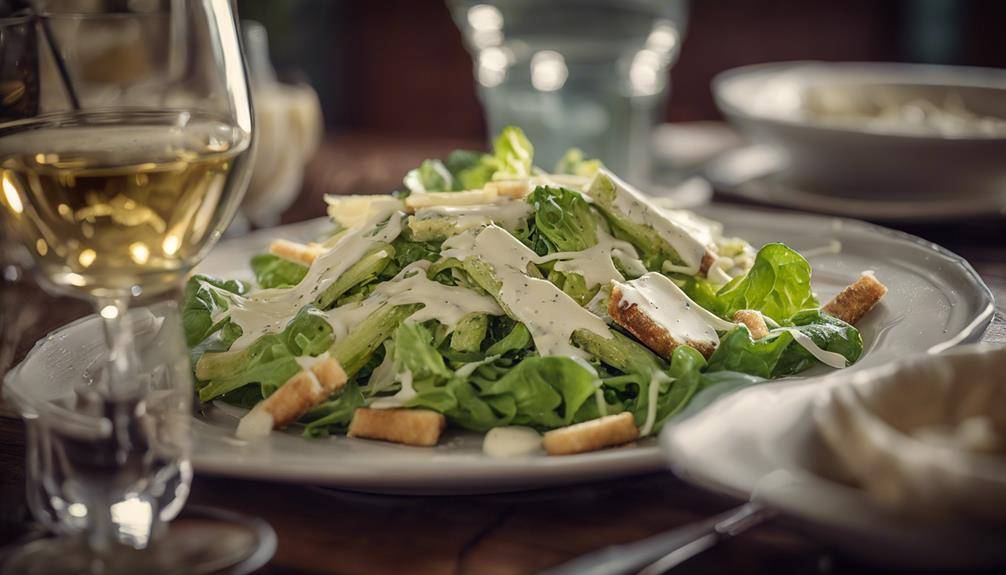
When serving Caesar dressing, drizzle it generously over crisp romaine lettuce, adding croutons and shaved Parmesan for a classic touch. This simple combination creates a deliciously satisfying salad that’s hard to resist. But don’t stop there! You can elevate your Caesar experience by exploring various salad pairings. For a heartier option, consider tossing in grilled chicken or shrimp, which not only enhances the flavor but also turns your salad into a complete meal.
If you’re looking for a vegetarian twist, roasted vegetables like zucchini or bell peppers can add depth and color to your dish. You might also experiment with toppings like avocado or cherry tomatoes for a fresh twist.
Now, let’s talk about bread choices. A Caesar salad pairs beautifully with crusty bread such as a baguette or ciabatta. You can slice it into pieces and toast it lightly for a delightful crunch. Alternatively, you could opt for garlic bread, which complements the flavors of the dressing remarkably well.
For a lighter option, serve your salad alongside whole grain crackers or pita chips. They’ll add a satisfying crunch without overpowering the fresh tastes of the salad.
Whether you’re enjoying it as a side dish or a main course, these suggestions will help you create a meal that’s both delicious and memorable. So go ahead, get creative with your pairings and enjoy every bite!
How To Make Caesar Dressing; Frequently Asked Questions
Can I Use Store-Bought Ingredients for Caesar Dressing?
Yes, you can definitely use store-bought ingredients for Caesar dressing. It offers convenience, but remember to check the ingredient quality. Sometimes, fresh ingredients enhance flavor, so consider mixing both for the best results.
How Long Does Homemade Caesar Dressing Last in the Fridge?
Homemade Caesar dressing lasts about 3 to 5 days in the fridge. For ideal shelf life, store it in an airtight container and keep your ingredients fresh to maintain flavor and safety. Enjoy it while it’s tasty!
Is Caesar Dressing Vegetarian or Vegan-Friendly?
Caesar dressing typically isn’t vegetarian or vegan because it often contains anchovies and Parmesan cheese. If you’re looking for alternatives, try using plant-based cheeses and skipping the anchovies for a delicious, cruelty-free version.
What Are Common Mistakes When Making Caesar Dressing?
When making Caesar dressing, avoid common mistakes like improper emulsion techniques that can lead to separation. Also, be cautious with ingredient substitutions, as they can alter the flavor and texture you’re aiming for.
Can I Freeze Caesar Dressing for Later Use?
You can freeze Caesar dressing, but be mindful of the dressing consistency. Use proper freezing techniques, like portioning it into airtight containers, to maintain flavor and texture when you thaw it later.
Conclusion
Now that you know the origins, key ingredients, and preparation methods for Caesar dressing, you’re ready to whip up your own delicious version. Don’t hesitate to experiment with variations and find what suits your taste best. Remember, the perfect dressing is all about balance and freshness. Whether you’re drizzling it over a crisp salad or using it as a dip, your homemade Caesar dressing will elevate any meal. Enjoy the culinary journey and impress your friends and family!




